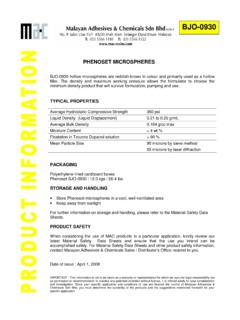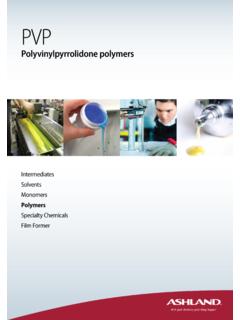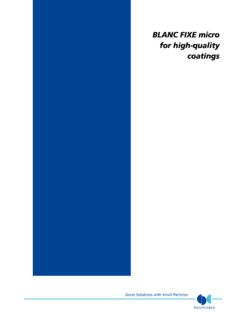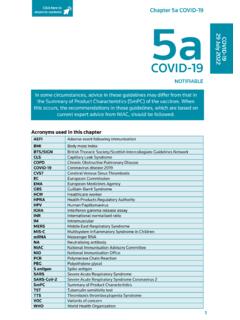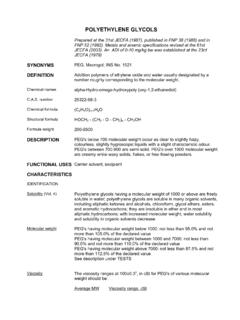Transcription of PVP - Brenntag
1 With good chemistry great things happen. PVPP olyvinylpyrrolidone polymersIntermediates Solvents Monomers PolymersSpecialty ChemicalsFilm Former234 Table I: PVP polymers General PropertiesCommercial Types of PVP polymersPVP polymers are available in several viscosity grades, ranging from low to high molecular weight. This range, coupled with solubility in aqueous and organic solvent systems combined with its nontoxic character, are some of the properties that gives PVP polymers great flexibility across multiple applications. The industrial applications of PVP polymers include, for example, in adhesives to improve strength and toughness; in paper manufacture to increase strength and as a coating resin; and in synthetic fibers to improve dye receptivity. PVP polymers are also widely employed in inks, imaging, lithography, detergents and soaps, the textile, ceramic, electrical and metallurgical industries and as a polymerization nonionic polymerHigh polarity/proton acceptorAmphiphilicCompatible with a variety of resins and electrolytesSoluble in water and polar solvents, insoluble in esters, ethers, ketones and hydrocarbonsUnsuitable for thermoplastic processingHard, glossy, transparent, oxygen permeable films which adhere to a variety of substratesHygroscopicAdhesive and cohesive propertiesCross-linkablePhysiologically inertTables I, II and III list the PVP polymers commercially available and some typical properties of the polymers are supplied in various viscosity grades as a powder and/or aqueous solution.
2 The full line of PVP polymers are also available for personal care applications such as film forming, emulsion stabilization and colorant dispersion. Ashland also offers pharmaceutical and agriculture grades of PVP polymer; our Plasdone and Polyplasdone polymer products are used in the pharmaceutical industry, Agrimer polymers are used by the Agriculture Types of PVP polymers ..4 Physical and Chemical Properties ..6 Molecular Weight Determination ..6 Viscosity ..6 Solubility ..9 Film-Forming Properties ..10 Compatibility ..10 Protective-Colloid Action ..12 Complex Formation/Crosslinking ..12 Stability ..12 Industrial Application of PVP polymers ..135 Table II: PVP polymer Solution and Powder ProductsPropertyP V P K-12P V P K-15 PVP K-30 PVP K-60 PVP K-90P V P K-120 Appearance @ 25 COff-white amorphous powderPale yellow aqueous solutionOff-white amorphous powderColorless to pale yellow aqueous solutionOff-white amorphous powderYellow aqueous solutionYellow viscous, aqueous solutionOff-white, amorphous powderColorless to yellow aqueous solutionOff-white, amorphous powder K-Value (Viscosity of 1% solution)10 -14a13 -19a13 -19a27-3326 -3550-628 0 -10 09 0 -10 0110 -13 010 8 -130 Color (APHA)<50a4 max.
3 (VCS)10 0 ma x .80 0 -3195 -2495 - 1395 -725 -715 - 805 (combustion)< . 0125 . (5% aqueous solution)3-56-93-76-93-73-74-93-76-94-8 Brookfield Viscosity, cps (5% solids @ 25 C)--1-310-150-350 Specific Gravity @ 25 C-1. 0 Density (g/cc) Density (g/cc) ---Freezing Point C-- Heat (cal/g/KC)-0. polymer GradeK-ValueMolecular Weight (g/mol)Tg ( C )Radius of Hydration (GPC, nm)Radius of Gyration (MALS, nm)RH Triple DetectionRH DLSRg (18 angles)Rg (2 angles)K-1210 144,000 6,000120 2-3 K-1513 196,000 15,00013025 K-3026 3540,000 80,0001636101015K- 6050 62390, 000 470,00017012202123K-8583 88900,000 1,200,00017 2 K-9088 1001,000,000 1,700,00017432495865K-120114 1302,100,000 3,000,00017442606669a 5% aqueous solutionNOTE: This data is typical of current production, but are not necessarily III: PVP polymers properties PVP K-12 and K-15 polymer are too small for accurate MALS size 1: Effect of Concentration of Different Grades of PVP polymer on Viscosity of Aqueous Solutions at 25 C1101001000100001000000102030405060% PVPV iscosity, CentistokesK-120K-90K-60K-30K-15 Physical and Chemical PropertiesMolecular Weight DeterminationThere have been many studies that have been devoted to the determination of the molecular weight of PVP polymer.
4 The low molecular weight polymers have narrower distribution curves of molecular entities than the high molecular weight compounds. Some of the techniques for measuring the molecular weight of various PVP polymer products are based on mea suring sedimentation, light scattering, osmometry, NMR spectroscopy, ebullimometry, and size exclu sion chromatography for determining absolute molecular weight distribution. By the use of these methods, any one of three molecular weight parameters can be measured, namely the number average (Mn), viscosity average (Mv), and weight average (Mw). Each of these characteristics can yield a different answer for the same polymer as illustrated by using these measurement techniques in the analysis of the same PVP K-30 polymer sample. The following results are reported:Number average (Mn) 10,000 Viscosity average (Mv) 40,000 Weight average (Mw) 55,000 Therefore, in any review of the literature, one must know which molecular average is cited. Conventionally, molecular weights are expressed by their K-values, which are derived from relative viscosity K-values assigned to various grades of PVP polymer represent a function of the average molecular weight, the degree of polymerization and the intrinsic viscosity.
5 The K-values are derived from viscosity measurements and are calculated according to Fikentscher s formula: The K-value accepted for PVP polymer by pharmacopoeias and other authoritative bodies worldwide is measured by the viscosity technique and calculated by the use of Fikentscher s an aqueous solution PVP K-15 and PVP K-30 polymer, particularly in concentrations below 10%, have little effect on viscosity, whereas K-60 and K-90 considerably influence flow properties (Figure 1). In organic sol vents the viscosity of the solution is related to that of the solvent, Table relc75K021 + +K0K = 1000K0where c = concentration in g/100 ml solution rel = viscosity of the solutioncompared with solvent7 Table IV: Viscosities of PVP K-30 polymers in Various Organic SolventsKinematic Viscosities (in centistokes)Solvent2% PVP10% PVPA cetic Acid (glacial) 2 121,4-Butanediol101 425 Butyrolactone 2 8 Cyclohexanol 80 376 Diacetone Alcohol 5 22 Diethylene glycol 39 165 Ethanol (absolute) 2 6 Ethyl Lactate 4 18 Ethylene glycol 24 95 Ethylene glycol Monoethyl Ether 3 12 Kinematic Viscosities (in centistokes)Solvent2% PVP10% PVPG lycerin 480 2,046 Isopropanol 4 12 Methyl Cyclohexanone3 10N-Methyi-2-Pyrrolidone 2 8 Methylene Chloride1 3 Monoethanolamine27 83 Nitroethane 1 3 Nonylphenol 3,300 -Propylene glycol 66 261 Triethanolamine 156 666 Note.
6 Kinematic Viscosity in centistokes = Absolute Viscosity in centsitokes DensityPVP polymer solution viscosity does not change appreciably over a wide pH range, but increases in concentrated HCI. Strong caustic solutions precipitate the polymer, but this precipitate solution redissolves on dilution with water (Table V).Table V: Effect of pH on Viscosity of 5% Aqueous PVP K-30 polymer at 25 HCIV iscosity (cp) densities of PVP polymer water solutions are only slightly changed despite a significant increase in the concentration of PVP K-30 polymer, Table VI: Effect of PVP K-30 polymer Concentration on Density in WaterPVP Concentration (%)1020304050 Density at 2s c (g/ml) effect of temperature and concentration on viscosity is shown in Figures 2 and 3 for PVP K-30 and K-90 polymer respectively. Any possible effect of high temperatures and concentrations on finished formulations should be determined 2: Brookfield Viscosity of Aqueous PVP K-30 (w/w), %Brookfield viscosity, cP10 C25 C40 C60 CFigure 3: Brookfield Viscosity of Aqueous PVP K-90 polymer1101001000100001000000510152025 Concentration (w/w), %Brookfield viscosity, cP10 C25 C40 C60 CTable IV (continued)8 Figure 4: Gel Permeation Chromatograph1 of PVP polymer gradesFigure 5: Brookfield Viscosity of PVP polymer Molar MassMolar Mass (g/mol)DifferentialWeight FractionPVP K-12 PVP K-15 PVP K-30 PVP K-60 PVP K-90 PVP K-1201 GPC Conditions: Column: Single Shodex KB-80M, Mobile Phase: Water/Methanol, 50/50, v/v, molar LiNO3, FlowRate: ml/min, Injection Volume: 100 l, Temperature: 30 C, dn/dc = (%w/w)Brookfiled Viscosity ( ) at 25 CPVP K-12 PVP K-15 PVP K-30 PVP K-909 SolubilityPVP polymer is readily soluble in cold water and the concentration is limited only by viscosity.
7 It is possible to prepare free-flowing solutions of PVP K-30 polymer in concentrations up to 60% with only moderate effect on density. PVP K-60 and K-90 polymer are available commercially as 45 and 20 percent aqueous solutions, mol water per monomer unit is associated with the polymer molecule in solution. This is of the same order of magnitude as the hydration for various proteins reported in the K-30 polymer is also freely soluble in many organic solvents, including alcohols, some chlorinated compounds such as chloroform, methylene chloride and ethylene dichloride, nitroparaffins, and amines. It is essentially insoluble in hydrocarbons, ethers, some chlorinated hydrocarbons, ketones and solutions of PVP polymer in hydrocarbons may be prepared by the use of a cosolvent, , butanol, N-methyl-2-pyrrolidone, or nonylphenol. Clear 3-5% PVP polymer solutions in aliphatic hydrocarbons may be readily prepared by adding the hydrocarbon to a butyl alcohol solution of the polymer. In oil-based products, solubilization in an alkylphenol, , cetyl- or nonylphenol, is useful.
8 The alkylphenol is first heated to about 100 C and the PVP polymer added slowly with stirring. Then the temperature may be raised to approximately 200 C to accelerate VII: PVP K-30 polymer SolubilityAlcoholsmethanolethanolpropano lisopropanolbutanolsec-butanolamyl alcohol2-ethyl-l-hexanolcyclohexanolphen ol (50 C)ethylene glycol1,3-butanediol1,4-butanediolglycer inKetone-Alcoholdiacetone alcoholAcidsformic acidacetic acidpropionic acidEther-Alcoholsglycol ethersdiethylene glycoltriethylene glycolhexamethylene glycolpolyethylene glycol 4002,2 -thiodiethanolLactone -butyrolactoneEsterethyl lactateKetonemethylcyclohexanoneChlorina ted Hydrocarbonsmethylene dichloridechloroformethylene dichlorideLactams2-pyrrolidoneN-methyl-2 -pyrrolidoneN-vinyl-2-pyrrolidoneAminesb utylaminecyclohexylamineanline ethylenediaminepyridinemorpholine2-amino ethanoldiethanolaminetriethanolamineamin oethylethanolamlne2-hydroxyethylmorpholi ne2-amino-2-methyl-1-propanolNitroparaff insnitromethanenitroethaneThe following representative organic solvents will dissolve 10% or more PVP polymer at room temperature.
9 Hydrocarbons benzene toluene** xylenepetroleum etherhexaneheptane**Stoddard solvent**kerosene**mineral spiritsmineral oil cyclohexane methylcyclohexaneturpentineEthersdioxane ethyl ethermethyl ether ethyl vinyl ether isobutyl vinyl ether tetrahydrofuranChlorinated Hydrocarbonscarbon tetrachloridechlorobenzeneKetones methylethylketone acetonecyclohexanoneEstersethyl acetatesec-butyl acetatePVP polymer is essentially insoluble in the following solvents under the same conditions of testing:**PVP polymer is soluble in these hydrocarbons in about 5% concentration when added to the solvent as a 25% butanol Forming PropertiesDried unmodified films of PVP polymer are clear, transparent, glossy, and hard. Appearance does not vary when films are cast from different solvent systems, such as water, ethanol, chloroform, or ethylene plasticizers may be added without affecting clarity or luster of the film. Moisture taken up from the air by PVP polymer can also act as a plasticizer. Among the several commercial modifiers that may be used in concentrations of 10-50% (based on PVP polymer) to control tack and/or brittleness or to decrease hygroscopicity are:carboxymethylcellulose cellulose acetatecellulose acetate propionatedibutyl tartrate diethylene glycol dimethyl phthalate2-ethylhexanediol-1, 3glycerin glycerylmonoricinoleatelgepal C0-430 (Solvay)oleyl alcoholResoflex R-363 (Broadview Technologies)shellac sorbitolCarboxymethylcellulose, cellulose acetate, cellulose acetate propionate, and shellac effectively decrease tackiness.
10 Dimethyl phthalate is less effective, whereas glycerin, diethylene glycol , and sorbitol increase tackiness. Films essentially tack-free over all ranges of relative humidity may be obtained with 10% arylsulfonamide-formaldehyde comparative tests for plasticity at 33% relative humidity, PVP polymer films containing 10% diethylene glycol show an elongation at break twice that of PVP polymer films containing 10% glycerin, polyethylene glycol 400, sorbitol, or urea, and four times that of PVP polymer films containing 10% ethylene glycol , dimethyl phthalate. At 70% relative humidity, 25% sorbitol and 25% dimethylphthalate may be used polymer shows a high degree of compatibility, both in solution and film form, with most inorganic salt solutions and with many natural and synthetic resins, as well as with other chemicals (Table VIII).At 25 C the addition of 100 ml of a 10% solution of any of the following salts to 10% PVP K-30 polymer aqueous solution ( , 10 parts of the test salt to 1 part of PVP polymer) does not change the appearance of the solution:aluminum potassium sulfatealuminum sulfate ammonium chloride ammonium sulfate barium chloride calcium chloride chromium sulfate copper sulfateferric chloride magnesium chloride mercuric acetate nickel nitratelead acetate potassium chloride potassium sulfate potassium dichromate sodium bicarbonate** sodium chloride sodium nitratesodium phosphate (primary) sodium pyrophosphate sodium sulfatesodium sulfitesodium thiosulfate silver nitratezinc sulfate**200 ml if a 5% solutionAIK (S04)2 12H20AI2(SO4)h 18 H20NH4CI (NH4)2S04 BaCI2 H20 CaCI2.

